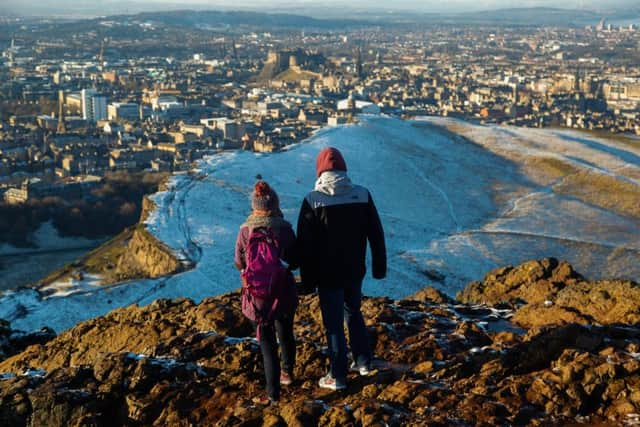Many of Scotland’s most precious areas of natural beauty are in ‘shocking’ decline
Sites including Arthur’s Seat in Edinburgh, which is protected for its wild grasslands, to the famous puffin colony at Sumburgh Head in Shetland face a number of threats ranging from climate change to invasive species.
There are 1,423 sites of special scientific interest (SSSI) north of the Border, which contain a total of 3,712 important environmental features such as significant geological examples or being home to a rare species of animal or plant.
Advertisement
Hide AdAdvertisement
Hide AdBut research by The Scotsman has found that, of the features assessed by Scottish Natural Heritage (SNH) – the public body responsible for ensuring the country’s nature is protected – almost one-third (32 per cent) were classed as being unfavourable.


Wildlife charities have branded the findings “shocking”, while SNH said it was taking action to restore sites.
SNH said many of the listed features were either recovering or were projected to recover.
The organisation said it had recently announced an extra £2 million of Scottish Government funding to boost biodiversity.
But Paul de Zylva, from Friends of the Earth, said it was “shocking that our top wildlife sites are in such poor condition”.
He said: “If we can’t even protect the jewels in the crown, it’s little wonder that UK nature is in such poor shape.”
Kate Jennings, head of site conservation policy at the Royal Society for the Protection of Birds (RSPB), said: “The current state of SSSIs across the four countries of the UK is shocking. Many have not been assessed for years, so the actual picture may, in fact, be worse.”
Other sites with unfavourable rankings include Inchlonaig, a privately-owned island in Loch Lomond that has been renowned for its woodland for centuries, but faces pressure from overgrazing and non-native species.
Advertisement
Hide AdAdvertisement
Hide AdAcross the UK, exactly half of the most recent inspections of protected land or natural features found poor conditions or the destruction of habitats, the analysis found.
The sites include a colony of puffins on Sumburgh Head in an unsatisfactory and declining state, with the situation blamed on climate change.
The nature reserve on Shetland, which is co-managed by the RSPB, has experienced an “apocalyptic” decline in numbers of seabirds nesting there. Figures show that, while there were 33,000 puffins on the island in the spring of 2000, the population stood at just 570 by 2017.
An RSPB Scotland spokeswoman said climate change was one of “the greatest threats” facing seabirds.
“To make our seabird colonies as resilient as possible in the face of climate change, some of the direct conservation measures we can take are minimising disturbance, improving nesting sites, managing biosecurity risks and protecting foraging areas at sea,” the body said.
Arthur’s Seat, the extinct volcano that dominates Edinburgh’s skyline, is a SSSI with three important features.
But the conditions of its grassland is rated as “unfavourable”, with “poor remedial management” blamed.
The hill, which offers commanding views of the Firth of Forth, is one of the Scottish capital’s most popular visitor destinations.
Advertisement
Hide AdAdvertisement
Hide AdA spokeswoman for Historic Environment Scotland (HES), which manages the site, said: “Holyrood Park is a unique site, comprising complex geology as well as a diverse collection of plants and wildlife, including over 60 rare plant species.
“We are working to address grassland management within the park as identified by SNH and to review grass cutting regimes in accessible areas. We will continue to work closely with SNH to explore management methods that continue to bring these unique grasslands into a favourable condition.
“While the condition of these areas of grassland is not solely related to increased visitor numbers, we are committed to balancing management of this unique and complex site while ensuring it remains open to a wide range of visitors.
“HES has implemented a range of measures to mitigate the impacts of both climate change and increased visitor numbers within the park, including upgraded drainage and path improvements.”
Many SSSI are under private ownership, but SNH said it had put in place several hundred management agreements with the aim of supporting farmers and landowners to place protected areas in favourable condition.
It also leads the four-year partnership Scottish Invasive Species Initiative (SISI) project, which is working to control invasive non-native species along riversides in northern Scotland.
A spokeswoman for SNH said: “It’s encouraging that when we include those features that are assessed as unfavourable, but on the road to recovery, then 82 per cent of features on sites of special scientific interest across Scotland are either doing well or projected to improve.
“To secure a nature-rich future for Scotland we must continue to address the significant challenges that nature faces, including invasive species, overgrazing and climate change, and we are working closely with partners, farmers and landowners to help them manage sites in a way that tackles these issues.
Advertisement
Hide AdAdvertisement
Hide Ad“SNH operates a monitoring programme which is split into six year cycles and is designed to prioritise those features which are most sensitive and vulnerable to change. For example, our butterflies are assessed more regularly than certain geological features. In between cycles of full site condition monitoring (SCM), regular site visits are carried out to ensure action can be triggered if any issues arise.”